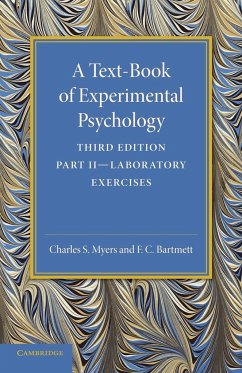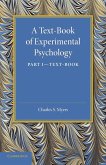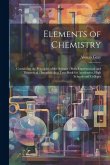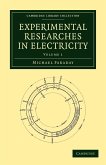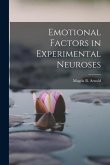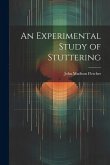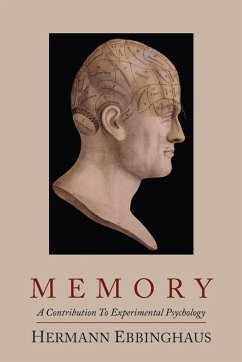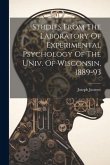Charles S. Myers, F. C. Bartlett
A Text-Book of Experimental Psychology
Volume 2, Laboratory Exercises: With Laboratory Exercises
Charles S. Myers, F. C. Bartlett
A Text-Book of Experimental Psychology
Volume 2, Laboratory Exercises: With Laboratory Exercises
- Broschiertes Buch
- Merkliste
- Auf die Merkliste
- Bewerten Bewerten
- Teilen
- Produkt teilen
- Produkterinnerung
- Produkterinnerung
First published in 1925, this second volume of Dr Charles Myers' two-part textbook suggests practical experiments to test psychological phenomena.
Andere Kunden interessierten sich auch für
![A Text-Book of Experimental Psychology A Text-Book of Experimental Psychology]() Charles S. MyersA Text-Book of Experimental Psychology50,99 €
Charles S. MyersA Text-Book of Experimental Psychology50,99 €![Elements of Chemistry: Containing the Principles of the Science: Both Experimental and Theoretical: Intended As a Text-Book for Academies, Hi Elements of Chemistry: Containing the Principles of the Science: Both Experimental and Theoretical: Intended As a Text-Book for Academies, Hi]() Alonzo GrayElements of Chemistry: Containing the Principles of the Science: Both Experimental and Theoretical: Intended As a Text-Book for Academies, Hi27,99 €
Alonzo GrayElements of Chemistry: Containing the Principles of the Science: Both Experimental and Theoretical: Intended As a Text-Book for Academies, Hi27,99 €![Experimental Researches in Electricity - Volume 1 Experimental Researches in Electricity - Volume 1]() Michael FaradayExperimental Researches in Electricity - Volume 166,99 €
Michael FaradayExperimental Researches in Electricity - Volume 166,99 €![Emotional Factors in Experimental Neuroses Emotional Factors in Experimental Neuroses]() Magda B ArnoldEmotional Factors in Experimental Neuroses20,99 €
Magda B ArnoldEmotional Factors in Experimental Neuroses20,99 €![An Experimental Study of Stuttering An Experimental Study of Stuttering]() John Madison FletcherAn Experimental Study of Stuttering18,99 €
John Madison FletcherAn Experimental Study of Stuttering18,99 €![Memory; A Contribution to Experimental Psychology Memory; A Contribution to Experimental Psychology]() Hermann EbbinghausMemory; A Contribution to Experimental Psychology15,99 €
Hermann EbbinghausMemory; A Contribution to Experimental Psychology15,99 €![Studies From The Laboratory Of Experimental Psychology Of The Univ. Of Wisconsin, 1889-93 Studies From The Laboratory Of Experimental Psychology Of The Univ. Of Wisconsin, 1889-93]() Joseph JastrowStudies From The Laboratory Of Experimental Psychology Of The Univ. Of Wisconsin, 1889-9320,99 €
Joseph JastrowStudies From The Laboratory Of Experimental Psychology Of The Univ. Of Wisconsin, 1889-9320,99 €-
-
-
First published in 1925, this second volume of Dr Charles Myers' two-part textbook suggests practical experiments to test psychological phenomena.
Hinweis: Dieser Artikel kann nur an eine deutsche Lieferadresse ausgeliefert werden.
Hinweis: Dieser Artikel kann nur an eine deutsche Lieferadresse ausgeliefert werden.
Produktdetails
- Produktdetails
- Verlag: Cambridge University Press
- Seitenzahl: 130
- Erscheinungstermin: 24. September 2013
- Englisch
- Abmessung: 216mm x 140mm x 7mm
- Gewicht: 174g
- ISBN-13: 9781107626027
- ISBN-10: 1107626021
- Artikelnr.: 41243465
- Herstellerkennzeichnung
- Libri GmbH
- Europaallee 1
- 36244 Bad Hersfeld
- gpsr@libri.de
- Verlag: Cambridge University Press
- Seitenzahl: 130
- Erscheinungstermin: 24. September 2013
- Englisch
- Abmessung: 216mm x 140mm x 7mm
- Gewicht: 174g
- ISBN-13: 9781107626027
- ISBN-10: 1107626021
- Artikelnr.: 41243465
- Herstellerkennzeichnung
- Libri GmbH
- Europaallee 1
- 36244 Bad Hersfeld
- gpsr@libri.de
1. Introductory
2. Free association
3. Perception and reproduction of forms
4. Recognition and recall
5. Process of construction
6. Process of analysis
7. Method of mean error
8. Limiting method
9. Method of serial groups
10. Constant method
11. Method of equal appearing intervals
12. Experiences of identity and difference
13. Absolute impression
14. Equal-appearing intervals of brightness
15. Reaction times
16. Simple and composite reactions
17. Heat and cold spots
18. Colour vision
19. Visual acuity
20. Auditory experience
21. Perception of form and size
22. Perception of distance and movement
23. Span of attention
24. Imaging
25. Memory
26. Muscular and mental fatigue
27. Mental tests
28. Cutaneous and thermal sensations
29. Labyrinthine and motor sensations
30. Gustatory sensations
31. Olfactory sensations
32. Visual sensations
33. Auditory sensations
34. Olfactory sensations
35. Sensory adaptation
36. Tactual localisation
37. Binocular experience
38. Optical illusions
39. Estimation of time intervals
40. Rhythm
41. The memory image
42. Muscular practice
43. Fluctuations of attention
44. Expression of feeling
45. Statistical methods.
2. Free association
3. Perception and reproduction of forms
4. Recognition and recall
5. Process of construction
6. Process of analysis
7. Method of mean error
8. Limiting method
9. Method of serial groups
10. Constant method
11. Method of equal appearing intervals
12. Experiences of identity and difference
13. Absolute impression
14. Equal-appearing intervals of brightness
15. Reaction times
16. Simple and composite reactions
17. Heat and cold spots
18. Colour vision
19. Visual acuity
20. Auditory experience
21. Perception of form and size
22. Perception of distance and movement
23. Span of attention
24. Imaging
25. Memory
26. Muscular and mental fatigue
27. Mental tests
28. Cutaneous and thermal sensations
29. Labyrinthine and motor sensations
30. Gustatory sensations
31. Olfactory sensations
32. Visual sensations
33. Auditory sensations
34. Olfactory sensations
35. Sensory adaptation
36. Tactual localisation
37. Binocular experience
38. Optical illusions
39. Estimation of time intervals
40. Rhythm
41. The memory image
42. Muscular practice
43. Fluctuations of attention
44. Expression of feeling
45. Statistical methods.
1. Introductory
2. Free association
3. Perception and reproduction of forms
4. Recognition and recall
5. Process of construction
6. Process of analysis
7. Method of mean error
8. Limiting method
9. Method of serial groups
10. Constant method
11. Method of equal appearing intervals
12. Experiences of identity and difference
13. Absolute impression
14. Equal-appearing intervals of brightness
15. Reaction times
16. Simple and composite reactions
17. Heat and cold spots
18. Colour vision
19. Visual acuity
20. Auditory experience
21. Perception of form and size
22. Perception of distance and movement
23. Span of attention
24. Imaging
25. Memory
26. Muscular and mental fatigue
27. Mental tests
28. Cutaneous and thermal sensations
29. Labyrinthine and motor sensations
30. Gustatory sensations
31. Olfactory sensations
32. Visual sensations
33. Auditory sensations
34. Olfactory sensations
35. Sensory adaptation
36. Tactual localisation
37. Binocular experience
38. Optical illusions
39. Estimation of time intervals
40. Rhythm
41. The memory image
42. Muscular practice
43. Fluctuations of attention
44. Expression of feeling
45. Statistical methods.
2. Free association
3. Perception and reproduction of forms
4. Recognition and recall
5. Process of construction
6. Process of analysis
7. Method of mean error
8. Limiting method
9. Method of serial groups
10. Constant method
11. Method of equal appearing intervals
12. Experiences of identity and difference
13. Absolute impression
14. Equal-appearing intervals of brightness
15. Reaction times
16. Simple and composite reactions
17. Heat and cold spots
18. Colour vision
19. Visual acuity
20. Auditory experience
21. Perception of form and size
22. Perception of distance and movement
23. Span of attention
24. Imaging
25. Memory
26. Muscular and mental fatigue
27. Mental tests
28. Cutaneous and thermal sensations
29. Labyrinthine and motor sensations
30. Gustatory sensations
31. Olfactory sensations
32. Visual sensations
33. Auditory sensations
34. Olfactory sensations
35. Sensory adaptation
36. Tactual localisation
37. Binocular experience
38. Optical illusions
39. Estimation of time intervals
40. Rhythm
41. The memory image
42. Muscular practice
43. Fluctuations of attention
44. Expression of feeling
45. Statistical methods.

